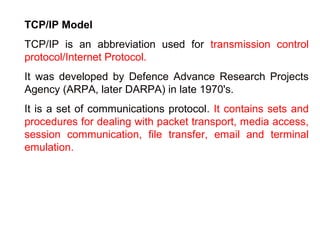
Ta 104-tcp
- 1. TCP/IP Model TCP/IP is an abbreviation used for transmission control protocol/Internet Protocol. It was developed by Defence Advance Research Projects Agency (ARPA, later DARPA) in late 1970's. It is a set of communications protocol. It contains sets and procedures for dealing with packet transport, media access, session communication, file transfer, email and terminal emulation.
- 2. The current internet is based on TCP/IP reference model. The model was defined by keeping following goals in mind. (i) The network should connect multiple networks together. (ii) The connection should withstand till the source and destination machines are functioning. (iii) The architecture should be so flexible that it should be able to transfer data among different hardware and/or software platforms.
- 4. Host to Network Layer This is the lowest layer in TCP/IP reference model. The functioning of this layer is generally different in different networks. The main job of this layer is to inform the upper layers about when the host is connected to the network; so that they could start sending the data packets. There are various networks like ARPANET, SATNET, X-25, ATM, ETHERNET, Token ring etc. into existence. The host has to connect to the network using some protocol, so that it can send the IP packet over it. Protocols used in this layer also vary from host to host and network to network.
- 5. Internet Layer The functioning of internet layer of TCP/IP model is same as the functioning of network layer of oSI model. At this layer the Internet Protocol (IP) is used. The task of this layer is to allow the host to insert packets into any network and then make them travel independently to the destination. The order in which the packets are received can be different from the sequence in which they were sent. Then the higher layers are supposed to arrange them in the proper order. So routing of packets and congestion control are important issues related to this layer.
- 6. Main functions of the internet layer are 1. Internetworking 2. Addressing 3. Routing 4. Packetizing 5. Data Switching 6. Congestion Control etc.
- 7. Transport layer The transport layer is situated above the internet layer of TCP model. The functioning of this layer is same as the functioning of transport layer in OSI model. In this layer, the byte stream is divided into message and these messages are passed on to the internet layer. The transport layer provides the services like segmentation and fragmentation of messages. It also handles the flow control so that a fast sender should not overflow a slow receiver.
- 8. The protocols used in this layer are 1) TCP :It is a reliable connection oriented protocol. It allows a byte stream transmitted from one machine to be delivered to the other machine without introducing any errors. TCP also handles the flow control. 2) UDP: (User Datagram Protocol) It is an unreliable, connectionless protocol and used for the applications which do not want the TCP's sequencing or flow control. It is used in transmitting speech or video.
- 9. Main functions of transport layer are: 1. Segmenting and reassembly 2. Sequence Numbering 3. Connection control 4. Flow control 5. Error control 6. Multiplexing
- 10. Application Layer This is the topmost layer of TCP/IP layer. It is the layer seen by the application program and hence is user oriented layer which provides services to support end user of network directly. A message or data to be sent across network enters the TCP/IP model at this point and then travels down ward into then through transmission line unto host-to-network layer of destination & then upwards up to application layer of receiver end system. It provides services that directly support user applications such as database access, email and file transfer.
- 11. This layer uses the various protocol to transfer the data between applications. Some common protocol used in this layer are: (a) FTP (File Transfer Protocol) FTP is used for file transfer between inter network nodes. b) SMTP (Simple Mail transfer Protocol) It is used for exchanging e-mail. c)Telnet It is used for remote terminal emulation. It enables user to access hostbased applications by emulating one of the host's terminals. Telnet provides connectivity between dissimilar operating systems. Telnet is a general purpose client-server application program.
- 12. d) DNS (Domain Name Systems) The DNS is used to convert the domain name into the IP addresses. To identify an entity, TCP/IP protocol use the IP address which uniquely identify the connection of a host to the internet. However, people prefer to use name instead of addresses. Therefore DNS maps a name to an address and conversely. (e) HTTP (Hypertext Transfer Protocol) HTTP is an internet protocol designed for a specific application, the World Wide Web (WWW).
